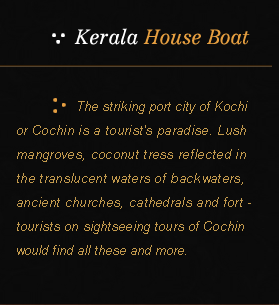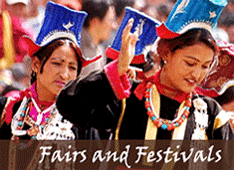Home > North India Tour Packages > Classical India with The Tiger Safari

Duration : 15 Days & 14 Nights
Location : Delhi – Varanasi – Khajuraho – Orchha – Agra – Ranthambore – Jaipur – Jodhpur – Kumbhalgarh – Udaipur.
Location : Delhi – Varanasi – Khajuraho – Orchha – Agra – Ranthambore – Jaipur – Jodhpur – Kumbhalgarh – Udaipur.
Day 01
Delhi Arrival:
COMPANY REPRESENTATIVE will receive you on arrival at the DELHI AIRPORT and transfer to your hotel.
DELHI, the capital of kingdoms and empires is now a sprawling metropolis with a fascinating blend of the past and the present. It is a perfect introduction to the composite culture of an ancient land. A window to the kaleidoscope - that is India.
Overnight will be at Delhi.
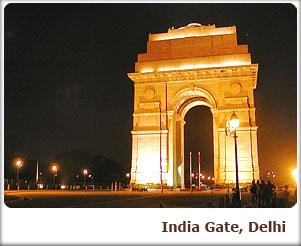 Day 02
Day 02
Delhi:
After breakfast proceed for a day sightseeing tour of the city.
The city is dotted with historic monuments that are the most popular tourist attractions in Delhi. Apart from the monuments, there are museums, markets, gardens and eating joints that you can visit on your tour of Delhi. Some of the important sightseeing places in Delhi are given below.
INDIA GATE: It is the war memorial dedicated to Indian soldiers, who died during World War I. The name of many soldiers who died during World War I is inscribed on its wall. Edward Lutyens, the man who planned and built New Delhi, designed India Gate. Almost every foreign tourist visits the monument. 'Amar Jawan Jyoti', the eternal flame is added later. The eternal flame runs on gas and is a tribute to soldiers who lost their lives in the service of the nation.
RED FORT: Located in Old Delhi, the Red Fort or Lal Quila is a popular tourist attraction in Delhi. The fort was built by the Mughal emperor Shah Jahan in 1648, when he moved his capital from Agra to Delhi. The construction of the Fort started in 1638 and it was completed 10 years later in 1648. Some of the important spots inside the Red Fort include royal baths or Shahi hamams, Shahi Burj, Moti Masjid or the Pearl Mosque, Diwan-e-Aam and Diwan-e-Khas.
JAMA MASJID: The largest mosque in India, the Jama Masjid was built by Shah Jahan 1656 AD. About 5,000 laborers and craftsmen worked for six years to complete the monument. The mosque can accommodate about 25,000 people. The mosque is located in the old Delhi. The domes are built in white marble. The prayer hall of the mosque has 260 pillars.
OLD FORT: Old Fort or Purana Quila as it is called is located near Pragati Maidan on the Mathura Road. You can club a visit to the Old Fort with your tour of Red Fort and Jama Masjid as the three monuments are located in Old Delhi and are not too far from one another. Humanyun’s started the construction of the fort in 1533 AD, but before the completion of the fort, Sher Shah Suri defeated him and captured Delhi. Sher Shah Suri completed the fort and named it -Shergah. He added many structures to the fort, of which Qila-I-Kuhna Mosque and Sher Mandal are worth mentioning. In 1555, Humanyun’s re-captured Delhi and converted Sher Mandal into a library.
HUMANYUN’S TOMB: Humanyun’s Tomb is mausoleum of the Mughal emperor Humanyun’s. Bega Begum also known as Haji Begum, wife of Humayun constructed the mausoleum for her husband. The tomb was built between 1562 and 1572 AD. The tomb was designed by Mirak Mirza Ghiyuth.
QUTAB MINAR: The construction of the Qutab Minar was stated by Qutub-ud-din Aibak in 1199 AD but he died before completing it. His son-in-law and successor Iltutmish completed the construction of the building. Qutab Minar is located in Meharauli.
LOTUS TEMPLE: Also known as the Bahai Temple, the monument was opened to public only in 1986. Located near Nehru Place, the Lotus Temple is designed like a lotus flower. If you are looking for some moments of peace and tranquility in the crowded city, Lotus Temple is the ideal place to visit.
Apart from the above-mentioned sightseeing options, there are various other tourist attractions that you can visit on your tour of Delhi. Some other sightseeing places in Delhi include Lodi Gardens, National Museum, Jantar Mantar, Dilli Haat and the Garden of Five Senses.
Overnight will be at Delhi.
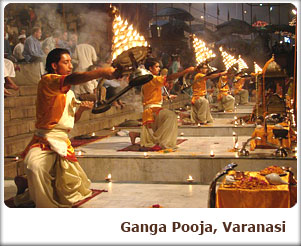 Day 03
Day 03
Delhi – Varanasi:
By Air
Breakfast will be at hotel.
Transfer in time to airport for flight to Varanasi. Upon arrival at Varanasi, you will be met and transferred to hotel.
Picturesquely situated on the crescent shaped left bank of the holy River Ganges, Varanasi, one of the ancient seats of learning in India, is said to be a compound of the names of two streams, the Varuna and the Assi, which still flow in the north and south of the city respectively. This name seems to have been corrupted, in medieval times to Varanasi, which was in use till May 1956, when it was changed to Varanasi, by an order of the Government of India. Varanasi is probably one of the most ancient living cities in India. From time immemorial it has been a great religious center for Hindus and one of their most sacred places of pilgrimage, being visited by millions of people every year. To every visitor Varanasi offers a breathtaking experience. The rays of the dawn shimmering across the Ganges; the high-banks; the temples and shrines along the banks bathed in a golden hue …soul stirring hymns and mantras along with the fragrance of incense filling the air…and the refreshing dip in the holy waters gently splashing at the Ghats. Varanasi – The land where experience and discovery reach the ultimate bliss. Varanasi is also renowned for its rich tapestry of music, arts, crafts and education. Some of the world – renowned exponents India has produced in these fields were schooled in Varanasi’s cultural ethos. Luminaries apart, Varanasi abounds in the art of silk weaving, an exotic work of art which manifests itself in precious Banarasi silk sarees and silk brocades which are cherished as collector’s items across the world today.
Proceed for the sightseeing.
Bharat Mata Mandir: Bharat Mata Mandir or Bharat Mata Temple is one of its kinds in Varanasi. Contrary to what most of the tourists believe, this temple is not dedicated to any God, Goddess or certain deity for that matter. It is dedicated to the human manifestation of India popularly called Mother India or Bharat Mata in Hindi. The temple was inaugurated by non other than Mahatma Gandhi, The father of the Indian Nation.
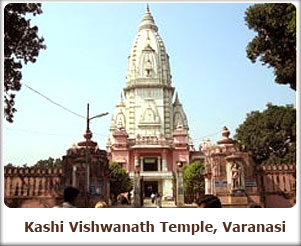 Banaras Hindu University: BHU was built in the year 1916-1917 under the special act of parliament passed in the year 1915 named BHU act. The act was passed by the interim parliament that worked under the imperial British government. Mahamna Pundit Madan Mohan Malaviya and Annie Besant did the conceptualization and implementation of this university. Raja of Kashi donated 1350 acres of land for the construction of the sprawling campus.
Banaras Hindu University: BHU was built in the year 1916-1917 under the special act of parliament passed in the year 1915 named BHU act. The act was passed by the interim parliament that worked under the imperial British government. Mahamna Pundit Madan Mohan Malaviya and Annie Besant did the conceptualization and implementation of this university. Raja of Kashi donated 1350 acres of land for the construction of the sprawling campus.
Durga Mandir: Goddess Durga is a significant manifestation of Parvati, the consort of Lord Shiva. In fact she is said to be Shakti, or the manifestation of Parvati that signifies the female element of Power and harmony in nature. This is precisely because a Bengali Maharani built this temple in the 18th century.
Kashi Vishwanath Mandir: The Vishwanath temple is synonymous to Varanasi. Vishwanath Temple is the most sacred and the most famous temple in Varanasi. In fact, Vishwanath Temple is extremely popular in other parts of India too. A considerable chunk of foreign visitors in India come to Varanasi every year to get a glimpse of the Vishwanath Temple even though the followers of Semitic religions are not allowed to enter the sanctum of the temple.
Tulsi Manas Mandir: Tulsi Manas Temple has a very historical as well as cultural importance for not only Varanasi but also for the whole of India. This is because Ramayana was composed at this very place. Goswami Tulsi Das was the man who composed Ramayana in Hindi in the form of "Ram Charit Manas".
Enjoy the evening AARTI at the GHATS. The guide will be giving a commentary to you on the proceedings and meanings of the chants during the AARTI of the river.
Later spend the evening shopping in the lanes of Varanasi.
Overnight will be at Varanasi.
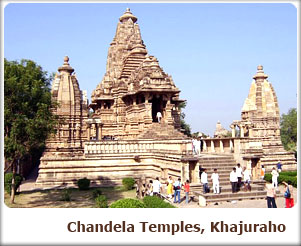 Day 04
Day 04
Varanasi – Khajuraho:
By Air
Proceed in the morning to Daswamedh Ghat and take a boat ride on the sacred river Ganges to see the cremation Ghats and witness the living traditions of one of the world's oldest and most important religions.
Cruise the Ganges. Perhaps the best way to enjoy the site of Varanasi’s Ghats is a cruise along the river at dawn. Hundreds of bathers, worshippers performing religious rites, holy men practicing yoga and people washing clothes gather at the river’s banks. (To start at 0500 hrs. for the best lifetime experience) For you to appreciate this remarkable city, we’ll transfer you to the banks of the River Ganges before the sun rises. Board a boat with your guide and proceed to the middle of the river, where at sunrise the sight unfolds before you. Thousands of faithful come daily to the banks to bathe and pray while in the background, temples and palaces rise in tiers from the water’s edge. Return for a walk through the cobblestone streets along the banks of "Ganga". As shops are opening, the place now becomes a beehive of activity as the faithful are coming and going.
Return to hotel for a sumptuous breakfast.
Proceed to the airport for flight to Khajuraho. Reach and check into the hotel.
Khajuraho, which has lent its name to a complex of exquisite Hindu and Jain temples, is a small town located amidst the forested plains of Bundelkhand in north-central Madhya Pradesh. The beautiful temples that dot Khajuraho are believed to have been built by the mighty Chandela rulers in the 9th and 10th century AD. The engravings on these temples are highly sensual and erotic that depicts in graceful forms intimate scenes of the whole range of human emotions and relationships. These sculptures congeal in stone a lyrical paean to love and passion and reflect the Chandela dynasty/’s immense appreciation for art.
Architecturally, the temples are built in the north Indian Nagara style. The sculptor/’s fine skill and a sense of imagination have given form to human emotion in the form of spiritual and physical love. Every façade—wall, window, pillar, and ceiling—is carved with figures of mythical and historical origins, and while many of these depict full-breasted, girdle-waisted women in forms of innocent play, they also depict carnal love.
Khajuraho combines history, architecture, culture and environment with delectable charm. It is a town that takes you away from the noise and pollution of the city, with its fresh air and scenic countryside. For convenience, the temples of Khajuraho are divided into the Western, Eastern, and Southern groups. The Western Group, situated opposite the Government of India Tourist Office, has 14 temples. The Chaunsath Yogini, Lalguan Mahadev, Parvati, Varaha, Matangesvara, Lakshmana, Vishvanath and Nandi, Chitragupta, Devi Jagdamba and Kandariya Mahadeo temples belong to this group. The Eastern Group, 2.4 km from the Tourist Office, consists of seven temples (four Jain and three Hindu). The Parsvanath, Adinath, Shantinath, and Ghantai temples belong to the Jains while the Vamana, Javari and Brahma are Hindu temples. The Southern Group, about 5 km from Khajuraho, contains the Chaturbhuj and Duladeo temples.
Visit the WESTERN SET OF TEMPLES.
Enjoy the Light and Sound show in the evening.
Overnight will be at Khajuraho.
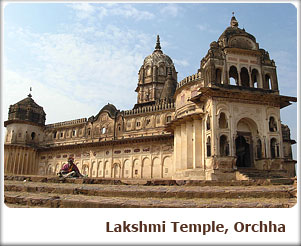 Day 05
Day 05
Khajuraho – Orchha - Jhansi;
By Road 175Kms/04hrs
Jhansi – Agra
By Deluxe train
Enjoy breakfast at the hotel.
Visit the EASTERN SET OF TEMPLES.
Drive to Jhansi railway station visiting Orchha enroute.
ORCHHA - The grandeur and opulence of the former Bundela dynasty is well reflected in Orchha set amidst the flat Bundelkhand countryside. Built by Raja Rudra Pratap on an artificial island on Betwa river, Orchha (17 Km from Jhansi) takes you back to a royal era when Bundela rulers enjoyed the finer things of life cocooned in the comforts of their citadel. Orchha is a photographer's delight. With its forts, regal palaces, striking temples and chattris, it narrates a beautiful medieval tale.
Transfer to JHANSI station after early lunch for SUPERFAST SHATABDI EXPRESS to Agra. Reach Agra at 2000 hr. Reach and check in at hotel.
AGRA: Two great Mughal monarchs, Akbar and Shah Jahan, transformed the little village of Agra into a befitting second capital of the Mughal Empire – giving it the name Dar-ul-Khilafat {seat of the Emperor}. Today a visitor to Agra is caught up in a world of contrasting edifices, of red sandstone and white marble, narrow galleys and quaint buggies, and that irresistible charm that this favorite city of the Mughals still retains. It is not surprising, that modern Agra still reflects its Mughal heritage most conspicuously. A walk down the narrow bustling streets of the city will introduce the visitor to the wafting aroma of Mughlai cuisine.
Overnight stay will be at Agra.
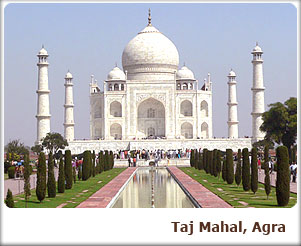 Day 06
Day 06
Agra:
After breakfast proceed for day sightseeing of Agra.
THE TAJ MAHAL – AN EMPEROR’S LAMENT: Agra is the city of the Taj Mahal. It is a sublime experience of the greatest love story ever told. Today India's most fascinating and beautiful masterpiece, this perfectly symmetrical edifice is set amidst landscaped gardens on the banks of the Yamuna River. The Taj was built by the Mughal Emperor Shahjahan as a memorial to his wife, Mumtaz Mahal. After her untimely death, Shah Jahan had her mortal remains buried in this mausoleum. And after his own demise he was placed to rest next to his beloved queen in the same mausoleum. Under the dome, below the ground level, in a dimly lit chamber, lie the mortal remains of Shahjahan and his beloved queen Mumtaz, reminding the world of their undying love. The Taj remains closed for visitors on Friday
AGRA FORT – ARCHITECTURAL WONDER IN STONE: Within a radius of 3 kilometers, on the banks of the river Yamuna raises the crescent like Agra Fort. Designed and built by Akbar in 1565 A.D., the fort is surrounded by a 70 feet high wall. It houses the beautiful Pearl Mosque and numerous palaces including the Jahangir Mahal, Diwan-i-Khas, Diwan-i-Am and Moti Masjid. Later it was used by his son Jahangir also as the seat of power. Shahjahan modeled his creation, the Red Fort at Delhi on this fort. The Agra fort happens to be on the same bank of the river Yamuna as the Taj Mahal which is visible in all its beauty from one side of the fort. So very ironically, Shahjahan, a prisoner of his son Aurangzeb in his old age was put in a cell from where he could gaze at the Taj Mahal at a distance, from his cell in the Agra Fort.
The fort has four gates and is enclosed by a double barricaded wall of red sand stone. Many buildings were constructed within the fort of which very few remain till date. One of the most significant ones is the multi storied Jahangir Mahal built by Akbar for his wife Jodha Bai.
The Mahal is reached through an impressive gateway and its inner courtyard consists of beautiful halls, profuse carvings on stone, exquisitely carved heavy brackets, piers and cross beams.
SIKANDRA: Sikandra, 10 Kms North West of Agra, is the final resting place of Emperor Akbar. The Tomb of Akbar shows an interesting fusion of Hindu and Mughal architecture reflecting the spirit of the Mughal Emperor Akbar. Akbar began the construction of his own garden mausoleum during his lifetime, a red sandstone structure in a char-Bagh meaning 4-square formal garden.
ITMAD – UL – DAULAH’A TOMB: This tomb was erected by Nur Jahan in sweet memory of her father Ghiasud-Din-Beg between 1622 - 1628 A.D. This white marble structure of the pre-Taj era though smaller is often considered equal if not better to the great one itself.
Overnight will be at Agra.
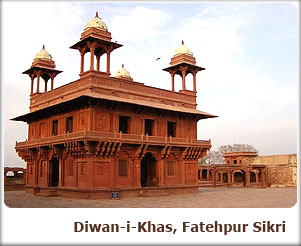 Day 07
Day 07
Agra – Fatehpur Sikri - Ranthambhore:
By Road 290Kms/06hrs
Breakfast will be at hotel.
Drive to Ranthambhore visiting Fatehpur Sikri enroute.
FATEHPUR SIKRI – THE CITY OF VICTORY: 37 Kms from the city of Agra, stands Fatehpur Sikri, Akbar’s capital. Full credit goes to the Archeological Survey of India for this perfectly preserved example of a Mughal city at the height of the empire’s splendor. It is an attraction no visitor to Agra should miss. This sprawling structure is made of red sandstone and combines both Hindu and Mughal architecture. This walled city contains the mausoleum of the Sufi fakir, Saleem Chisti who is said to have granted Akbar and his Hindu queen Jodhabai their wish for a son. The main entrance to Fatehpur Sikri is through the 175 feet Buland Darwaza, the highest gateway in the world. It was built by Akbar to commemorate his victory over Khandesh in Gujarat.
The Panch Mahal is a five-storeyed tower, the highest point in Fatehpur Sikri. This extremely airy tower is supposed to have been used by one of the emperor's many queens.
Continue your drive to Ranthambore.
Ranthambore National Park is in Sawai Madhopur District of Rajasthan state. Located at the junction of the Aravalli and Vindhya hill range, this is one of the finest places to view animals, especially as they are used to being stared at here. The park covers an area of Approximately 400 sq Km and if combined it with the area of sawai man singh sanctuary area, it is around 500 Sq km.
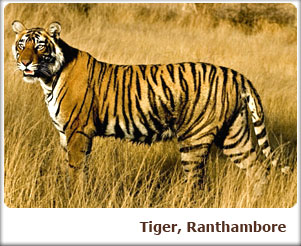 Ranthambore national park was declared a wildlife sanctuary in 1957 and in 1974 it gained the protection of "Project Tiger". It got its status of a National Park in 1981. Ranthambore National Park is dotted with structures that remind you of bygone eras. There are many water bodies located all over the park, which provide perfect relief during the extremely hot summer months for the forest inhabitants. A huge fort, after which the park is named, towers over the park atop a hill. There are many ruins of bygone eras scattered all over the jungle, which give it a unique, wonderful and mixed flavor of nature, history and wildlife. Tigers at Ranthambore National park have been known to even hunt in full view of human visitors. These tigers are famous for being seen in the daytime too, due to their lack of fear of human presence in vehicles. This lack of fear of humans is excellent for tourists, as they get to see the tigers often.
Ranthambore national park was declared a wildlife sanctuary in 1957 and in 1974 it gained the protection of "Project Tiger". It got its status of a National Park in 1981. Ranthambore National Park is dotted with structures that remind you of bygone eras. There are many water bodies located all over the park, which provide perfect relief during the extremely hot summer months for the forest inhabitants. A huge fort, after which the park is named, towers over the park atop a hill. There are many ruins of bygone eras scattered all over the jungle, which give it a unique, wonderful and mixed flavor of nature, history and wildlife. Tigers at Ranthambore National park have been known to even hunt in full view of human visitors. These tigers are famous for being seen in the daytime too, due to their lack of fear of human presence in vehicles. This lack of fear of humans is excellent for tourists, as they get to see the tigers often.
This National park is a wildlife enthusiast and photographer's dream. It offers excellent accommodation and internal transportation facilities. The park remains open every year from October to May. Famous for the exciting and frequent tiger sightings captured dramatically in several books, this park is today affected by ecological pressures and poaching.
In Nutshell, Ranthambore National park is a wildlife enthusiast and photographer's dream.
Timings for entry into, and exit from, the park vary according to the season. In winters, due to the shorter duration of daylight hours, the morning entry time is later and evening exit time is earlier.
Overnight will be at Ranthambore.
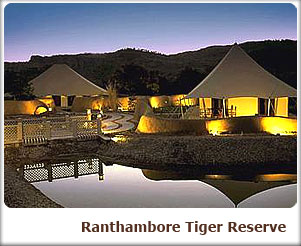 Day 08
Day 08
Ranthambore:
Wake up early morning and leave for your safari into the National Park. Track the tigers and other wildlife through the morning. Return to the resort / lodge by 1000 in the morning and have breakfast.
Freshen up and either spends time at the pool or visit the town. You could also go for a nice visit to the temple on top of the fort.
In the afternoon have lunch and then leave again for you afternoon safari. The safari will be till evening 1700 – 1800 hr and then return to the resort / lodge.
Dinner will be at the resort and retire early for the night.
Overnight will be at Ranthambhore.
Day 09
Ranthambore – Jaipur:
By Road 175Kms/04hrs
After breakfast drive to beautiful Pink City – Jaipur. Reach and check in at hotel.
Jaipur is the capital of the state of Rajasthan a romantic realm of resplendent palaces, mighty fortresses and regal Maharajahs that lies in the western deserts and is an utterly unique part of India. Proudly belonging to the KSHATRIYA warrior caste and fiercely independent, the Rajput princes made fearsome foes. However, many of them realized that to maintain their wealth and authority locally, it was expedient to proclaim allegiance to the central power. Thus, many enjoyed a privileged position under the Mughal emperors and also the British Raj that followed.
The bustling Rajasthan capital of Jaipur takes its name from its venerated founder Jai Singh II, who was given the title Sawai Maharaja by the Mughal. Literally translated this would mean ’one and a quarter’, suggesting that the Mughal thought this emperor to be more valuable than just ‘one’. Jaipur is known as the ’Pink City’ on account of the distinctive colour of its buildings. This did not, however, form part of the original plan, but dates back to 1856, when the city was given a wash of pink in honor of a State Visit from Prince Albert.
This evening, visit the Birla Temple to learn more about the fascinating religious life of Jaipur. The marble structure, built as recently as 1985, houses ornate statues including one of Lakshmi (goddess of Wealth and Beauty) and Narayan dressed in gaudy robes, representing a Hindu vision of heavenly luxury. Carvings in the temple and on pillars supporting the covered walkways include images of the Hindu pantheon, as well as Jesus, the Blessed Virgin Mary and St Francis of Assisi. Your visit will coincide with the AARTI Ceremony, which involves oil lamps being lit and waved, in order to awake and invoke the deity.
Enjoy the experience and spend night at Jaipur.
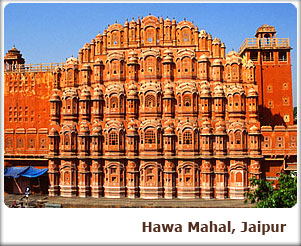 Day 10
Day 10
Jaipur:
After breakfast drive to Amber Palace. Enjoy Elephant Back ascent to the Fort.
AMBER PALACE & FORT: Amber Fort and Palace was originally built by Raja Man Singh and subsequently developed by Sawai Jai Singh. The major attractions are Sheela Devi Temple, Sheesh Mahal (Hall of mirrors), Jai Garh Fort a few kilometers from the city centre was built for the defence of the town and has one of the world’s biggest cannons on wheels and a rich collection of arms and weapons.
Continue city sightseeing.
HAWA MAHAL (PALACE OF WINDS): Hawa Mahal is the most strikingly designed monument in Jaipur. Built by the Poet-King Sawai Pratap Singh in 1799, the Hawa Mahal is centrally located and is multiniched five storey high back view of the compled. It was conceived to provide an adequate vantage position behind delicate stone-carved jali, screens for the palace women to watch the royal processions passing through the Bazar below without being seen by outsiders. The Top of the palace affords a beautiful view of the city. A small archaeological museum is yet another attraction in the palace.
JAL MAHAL: The Jal Mahal Palace, Jaipur is noted for its intricate architecture. The Palace was developed as a pleasure spot. It was used for the royal duck shooting parties. On the road to Amber at a distance of 6.5 Kms from Jaipur are the cenotaphs of the royal family. A causeway leads to Jal Mahal Palace situated in the middle of Man Sagar Lake, opposite the cenotaphs. The first four floors of this building is under water, only the top floor remains outside. One can have a wonderful view of the lake and the palace from Nahar Garh Fort Built in 1799, the palace is now abandoned, but reasonably well preserved. In the monsoons, it looks particularly startling with its red sandstone set against the water hyacinth filled lake.
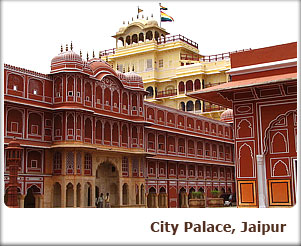 THE CITY PALACE: The city Palace is a historic landmark. The Carved arches are supported by grey-white marble columns studded with floral motifs in gold and colored stones. Two elephants carved in marble, guard the entrance, where retaineers whose families have served generations of the rulers are at hand, to serve as guides.
THE CITY PALACE: The city Palace is a historic landmark. The Carved arches are supported by grey-white marble columns studded with floral motifs in gold and colored stones. Two elephants carved in marble, guard the entrance, where retaineers whose families have served generations of the rulers are at hand, to serve as guides.
JANTAR MANTAR Jantar Mantar is one of Sawai Jai Singh’s five remarkable observatories. Constructed with stone and marble its compled instruments, whose setting and shapes are precisely and scientifically designed, represent the high-points of medieval Indian Astronomy. The two Ram Yantras used for gauging altitudes are unique in their isolation. This is the largest of five observatories founded by Sawai Jai Singh-II in various parts of the country.
This evening is free for you to relax shop or explore independently. Shopping is superb in Jaipur, particularly for gold and silver jewellery, pottery, tie-dye materials, silk, saris, wooden handicrafts and carpets.
Overnight will be at Jaipur.
Day 11
Jaipur – Jodhpur:
By Road 300Kms/06hrs
Breakfast will be at hotel.
Proceed to Jodhpur by road. Reach Jodhpur and check into hotel.
Set at the edge of the Thar Desert, the imperial city of Jodhpur echoes with tales of antiquity in the emptiness of the desert. Once the capital of the Marwar state, it was founded in 1459 AD by Rao Jodha-chief of the RATHORE clan of Rajputs who claimed to be descendants of Rama - the epic hero of the RAMAYANA. The massive 15th century AD Mehrangarh Fort looms on the top of a rocky hill, soaring 125 Mts. Above the plains. The city is encompassed by a high wall -10 km long with 8 gates and innumerable bastions.
Visit UMAID BHAWAN PALACE: The romantic looking Umaid Bhawan Palace was actually built with the purpose of giving employment to the people of Jodhpur during a long drawn famine. The royal family of Jodhpur still lives in a part of the palace. Another part of the palace houses a well-maintained museum, displaying an amazing array of items belonging to the Maharaja and the royal family - weapons, antiques & fascinating clocks, crockery and trophies
Overnight will be at Jodhpur.
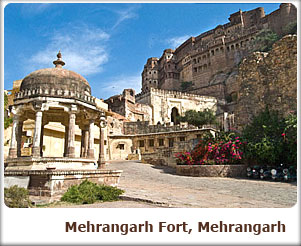 Day 12
Day 12
Jodhpur – Kumbhalgarh:
By Road 200Kms/05hrs
Enjoy the sightseeing of the city after the breakfast.
MEHRANGARH FORT: This fort is one of the largest forts in India. The fort is situated at an altitude of about 125 metres and is spread over an area of 5 sq km, with seven gates. It has been a witness to the splendor of bygone era. The beauty and the grandeur of numerous places in the fort narrate a saga of hard sandstones yielding to the chisels of skilled Jodhpur sculptures. Mehrangarh literally means "Majestic Fort". It is located at very center of the city and is visible surrounding from the city. Originally built in 1806 the fort has been added to many times since. The palaces in this fort were built in an informal pattern over several centuries. They have their own peculiar style, with narrow staircases, serving as the only means of access to the royal residences within. A collection of musical instruments, palanquins, furniture and cannons on the fort's ramparts are well - preserved.
JASWANT THADA: Close to the fort complex lies white marble cenotaph, built in 1899 in commemoration of Maharaja Jaswant Singh II rare portraits of Jodhpur rulers are also to be seen at Jaswant Thada. A visit inside the cenotaphs, with some villagers of the region, would bring forward the reverence they still hold for their brave kings.
In the late afternoon drive to Kumbhalgarh. Arrive and check into the hotel.
Cradled in the cluster of thirteen mountain peaks of the Aravalli ranges, the formidable medieval citadel- Kumbalgarh stands a wary sentinel to the past glory. Rising from a prominent ridge, 1914 metres high from the sea level, the fort was built in 15th century AD by Maharana Kumbha (1419-63 AD) and is the principal fortification after Chittaurgarh, lying 90 km north-west of Udaipur.
The massive fort, encompassed by a 36-km long wall, has seven majestic gates and seven ramparts, one within the other. Rounded bastions and high watchtowers strengthen the crenellated walls of the fort making it an impregnable structure.
 Generally, it is perceived that Kumbhalgarh (also written as Kumbhalgadh) is a virtually inaccessible 15th century fort. Many of the travelers who visit Kumbhalgarh have this notion itched overwhelmingly in their mind and they expect an abandoned medieval structure. Fortunately this is not the case and you can find Kumbhalgarh as the hub of delighted activities within easy reach, yet off the beaten track, from well-known destinations.
Generally, it is perceived that Kumbhalgarh (also written as Kumbhalgadh) is a virtually inaccessible 15th century fort. Many of the travelers who visit Kumbhalgarh have this notion itched overwhelmingly in their mind and they expect an abandoned medieval structure. Fortunately this is not the case and you can find Kumbhalgarh as the hub of delighted activities within easy reach, yet off the beaten track, from well-known destinations.
The town is most famous for the stunning Dilwara Jain temples, built between the 11th and 13th century. These intricately carved marble temples are amazing to behold-not an inch of space has been left uncarved; almost, as if, in a frenzy of inspiration, the artists carved and carved till they could carve no more! Mount Abu also has a pretty lake studded with little islets.
Relax in the evening and spend night at Kumbhalgarh.
Day 13
Kumbhalgarh – Ranakpur - Udaipur:
By Road 90Kms/02hrs
Breakfast will be at hotel.
Enjoy the sightseeing.
Kumbhalgarh Fort: Though little known, Kumbhalgarh has one of the finest examples of defensive fortifications in entire Rajasthan. Total length of the wall of this fort is 32 kilometers and there are excellent views from the top of the walls. Kumbhalgarh stands on the site of an ancient citadel dating back to the second century A.D., belonging to a Jain descendant of India's Mauryan emperors. Its steel gray ramparts encircle the fertile Shero Mallah Valley, with ancient monuments cenotaphs, ponds, and flourishing farms. In addition, a stroll along the walls of the fort gives great panoramic views.
Kumbhalgarh Wildlife Sanctuary: A hazardous, barely jeep able track takes you to the 586 square kilometers Kumbhalgarh Wildlife Sanctuary. The main attraction here would be panther, sloth bear, wild boar, four-horned antelope, or crocodiles. Crocodiles are "Scientifically Bred" in a lake in the Crocodile Farm. The Crocodile Farm has a guesthouse belonging to the Forest Department, and overnight stays are possible. Good forest cove, jungle berries, fruits and nuts, water grasses, algae sands of flamingoes, sarus cranes, spoonbills, painted storks, cormorants, purple heron, egrets, duck, and rosy pelican in winter. One also finds plenty of chakor partridge, crow pheasants, jungle warblers, golden orioles, gray jungle fowl, and the usual peacocks, parrots, pigeons, and doves.
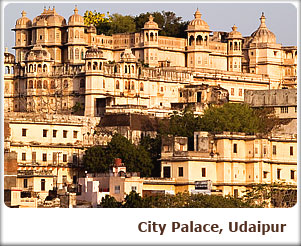 Proceed to Udaipur.
Proceed to Udaipur.
Visit Ranakpur en route. A visit to the famous Jain Temple, dating back to the 15th century is part of the itinerary. 200 pillars, none of which are alike, support its 29 halls. The Temple abounds with intricate friezes and sculptures. Includes visits to two more Jain temples and the Temple of the Sun God with its erotic sculptures.
Reach Udaipur and check in at hotel.
The city of Dawn, Udaipur is a lovely land around the azure lake, hemmed in by the lush hills of the Aravallis. A vision in white drenched in romance and beauty, Udaipur is a fascinating blend of sights, sound and experiences and inspiration for the imagination of poets, painters and writers. Its kaleidoscope of fairy-tale palaces, lakes, temples, gardens and narrow lanes strewn with stalls, carry the flavor of a heroic past, epitomizing valor and chivalry. Their reflection in the placid waters of the Lake Pichhola is an enticing sight.
Overnight will be at Udaipur.
Day 14
Udaipur
Breakfast will be at hotel.
Proceed for sightseeing tour of Udaipur, stopping first at City Palace.
CITY PALACE: Udaipur’s fascinating City Palace is the largest royal complex in Rajasthan. Standing on a rocky promontory the palace has balconies, towers and cupolas and presents a wonderful view of the lake and the city. The complex has eleven constituent Mahals (palaces), constructed by successive maharanas during the three hundred years that followed the foundation of Udaipur in 1559. Added to this, Crystal Gallery and Durbar Hall within the complex is spectacular. Explore them for their mosaics, miniatures, mirror work and motifs.
Here you will marvel at rooms with mirrored walls and ivory doors, colored glass windows and inlaid marble balconies and the Peacock Courtyard.
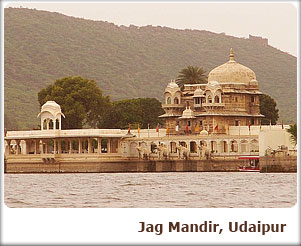 SAHELION KI BARI: The "garden of the maids of honour", Sahelion-ki-Bari was designed and laid out early in the eighteenth century as a retreat for ladies of the royal household to spend their time in leisure. The lotus pool, fountains, lawns, flowerbeds, and marble pavilions all combine to make it a captivating place.
SAHELION KI BARI: The "garden of the maids of honour", Sahelion-ki-Bari was designed and laid out early in the eighteenth century as a retreat for ladies of the royal household to spend their time in leisure. The lotus pool, fountains, lawns, flowerbeds, and marble pavilions all combine to make it a captivating place.
BAGORE KI HAVELI: Situated on the picturesque bank of Pichola Lake, This Haveli was built by Shri Amarchand Badwa, who was the Prime Minister of Mewar-the rulers of Mewar Pratap Singh, Maharana Ari Singh, and Maharana Hamir Singh during the period 1751 to 1778. This palatial building reportedly has 138 rooms, balconies, terraces, courtyards and corridors. The glass and mirror inlay within the Haveli is Unique and procured in its original form. The two peacocks made with small pieces of colored glasses are unique reflection of the finest craftsmanship of glass work. What was once upon a time a living centre of nobility of Udaipur lay in darkness and ruin for nearly half a century till when it was handed over to the West Zone Cultural Centre (WZCC) in 1986.
JAGDISH TEMPLE: Built in 1651 A.D. by Maharana Jagat Singh, this Indo-Aryan temple is dedicated to Lord Jagannath, a manifestation of Vishnu. The largest and the most beautiful temple of Udaipur, it is always seething with constant activity and noted for its beautiful sculpted images and towering Shikhara.
FATEH SAGAR: West of Sahelion-ki-Bari is Fateh Sagar, a lake built by Maharana Fateh Singh. It is bordered by sharp hills and a canal built at the beginning of the twentieth century connects it to the Lake Pichola. In the middle of the lake is Nehru Park, a popular garden island with a boat-shaped cafe.
BHARATIYA LOK KALA MANDIR: Bharatiya Lok Kala Mandir is home to an attractive collection of folk dresses, puppets, ornaments, dolls, masks, folk musical instruments, folk deities and paintings. The museum is the best place for those interested in puppetry. Short amusing puppet shows are staged throughout the day. In addition, the museum runs short courses in puppet making and theatre.
Proceed for Evening Motor launch cruise on the placid waters of Lake Pichola. From the boat you will be able to view the city of Udaipur as it rises majestically above the lake in the middle of the Rajasthan desert. Also visit the Jag Mandir Palace - the other island palace in the middle of the lake. Spend some time at the Jag Mandir Palace.
JAG MANDIR: Jag Mandir, another island palace in the Lake Pichola was built by Karan Singh in 1615. It derives its name from Jagat Singh who added to the initial structure. It was never used for the purpose for it was built. This palace was used to provide shelter to the Mughal prince Khurum (later Emperor Shah Jahan) who rebelled against his emperor father Jahangir, in the 1620s. Jahangir was succeeded by Shah Jahan who was still in Udaipur at the time of his father's death. During the 1857 Mutiny this island palace once again served as a safe haven for European women and children.
Overnight will be at Udaipur.
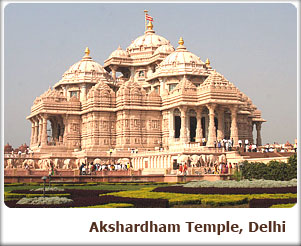 Day 15
Day 15
Udaipur – Delhi – Departure:
By Air
Morning enjoy the breakfast.
Transfer to the airport to take flight for Delhi.
Reach Delhi and enjoy last minute shopping.
As per your INTERNATIONAL FLIGHT TIMINGS you’ll be transferred to the airport to take your flight back home with sweet memories of CLASSICAL INDIA WITH THE TIGER SAFARI TOUR.
...........................................................................TOUR ENDS...........................................................................
INCLUSIONS:
Delhi Arrival:
COMPANY REPRESENTATIVE will receive you on arrival at the DELHI AIRPORT and transfer to your hotel.
DELHI, the capital of kingdoms and empires is now a sprawling metropolis with a fascinating blend of the past and the present. It is a perfect introduction to the composite culture of an ancient land. A window to the kaleidoscope - that is India.
Overnight will be at Delhi.
 Day 02
Day 02 Delhi:
After breakfast proceed for a day sightseeing tour of the city.
The city is dotted with historic monuments that are the most popular tourist attractions in Delhi. Apart from the monuments, there are museums, markets, gardens and eating joints that you can visit on your tour of Delhi. Some of the important sightseeing places in Delhi are given below.
INDIA GATE: It is the war memorial dedicated to Indian soldiers, who died during World War I. The name of many soldiers who died during World War I is inscribed on its wall. Edward Lutyens, the man who planned and built New Delhi, designed India Gate. Almost every foreign tourist visits the monument. 'Amar Jawan Jyoti', the eternal flame is added later. The eternal flame runs on gas and is a tribute to soldiers who lost their lives in the service of the nation.
RED FORT: Located in Old Delhi, the Red Fort or Lal Quila is a popular tourist attraction in Delhi. The fort was built by the Mughal emperor Shah Jahan in 1648, when he moved his capital from Agra to Delhi. The construction of the Fort started in 1638 and it was completed 10 years later in 1648. Some of the important spots inside the Red Fort include royal baths or Shahi hamams, Shahi Burj, Moti Masjid or the Pearl Mosque, Diwan-e-Aam and Diwan-e-Khas.
JAMA MASJID: The largest mosque in India, the Jama Masjid was built by Shah Jahan 1656 AD. About 5,000 laborers and craftsmen worked for six years to complete the monument. The mosque can accommodate about 25,000 people. The mosque is located in the old Delhi. The domes are built in white marble. The prayer hall of the mosque has 260 pillars.
OLD FORT: Old Fort or Purana Quila as it is called is located near Pragati Maidan on the Mathura Road. You can club a visit to the Old Fort with your tour of Red Fort and Jama Masjid as the three monuments are located in Old Delhi and are not too far from one another. Humanyun’s started the construction of the fort in 1533 AD, but before the completion of the fort, Sher Shah Suri defeated him and captured Delhi. Sher Shah Suri completed the fort and named it -Shergah. He added many structures to the fort, of which Qila-I-Kuhna Mosque and Sher Mandal are worth mentioning. In 1555, Humanyun’s re-captured Delhi and converted Sher Mandal into a library.
HUMANYUN’S TOMB: Humanyun’s Tomb is mausoleum of the Mughal emperor Humanyun’s. Bega Begum also known as Haji Begum, wife of Humayun constructed the mausoleum for her husband. The tomb was built between 1562 and 1572 AD. The tomb was designed by Mirak Mirza Ghiyuth.
QUTAB MINAR: The construction of the Qutab Minar was stated by Qutub-ud-din Aibak in 1199 AD but he died before completing it. His son-in-law and successor Iltutmish completed the construction of the building. Qutab Minar is located in Meharauli.
LOTUS TEMPLE: Also known as the Bahai Temple, the monument was opened to public only in 1986. Located near Nehru Place, the Lotus Temple is designed like a lotus flower. If you are looking for some moments of peace and tranquility in the crowded city, Lotus Temple is the ideal place to visit.
Apart from the above-mentioned sightseeing options, there are various other tourist attractions that you can visit on your tour of Delhi. Some other sightseeing places in Delhi include Lodi Gardens, National Museum, Jantar Mantar, Dilli Haat and the Garden of Five Senses.
Overnight will be at Delhi.
 Day 03
Day 03 Delhi – Varanasi:
By Air
Breakfast will be at hotel.
Transfer in time to airport for flight to Varanasi. Upon arrival at Varanasi, you will be met and transferred to hotel.
Picturesquely situated on the crescent shaped left bank of the holy River Ganges, Varanasi, one of the ancient seats of learning in India, is said to be a compound of the names of two streams, the Varuna and the Assi, which still flow in the north and south of the city respectively. This name seems to have been corrupted, in medieval times to Varanasi, which was in use till May 1956, when it was changed to Varanasi, by an order of the Government of India. Varanasi is probably one of the most ancient living cities in India. From time immemorial it has been a great religious center for Hindus and one of their most sacred places of pilgrimage, being visited by millions of people every year. To every visitor Varanasi offers a breathtaking experience. The rays of the dawn shimmering across the Ganges; the high-banks; the temples and shrines along the banks bathed in a golden hue …soul stirring hymns and mantras along with the fragrance of incense filling the air…and the refreshing dip in the holy waters gently splashing at the Ghats. Varanasi – The land where experience and discovery reach the ultimate bliss. Varanasi is also renowned for its rich tapestry of music, arts, crafts and education. Some of the world – renowned exponents India has produced in these fields were schooled in Varanasi’s cultural ethos. Luminaries apart, Varanasi abounds in the art of silk weaving, an exotic work of art which manifests itself in precious Banarasi silk sarees and silk brocades which are cherished as collector’s items across the world today.
Proceed for the sightseeing.
Bharat Mata Mandir: Bharat Mata Mandir or Bharat Mata Temple is one of its kinds in Varanasi. Contrary to what most of the tourists believe, this temple is not dedicated to any God, Goddess or certain deity for that matter. It is dedicated to the human manifestation of India popularly called Mother India or Bharat Mata in Hindi. The temple was inaugurated by non other than Mahatma Gandhi, The father of the Indian Nation.
 Banaras Hindu University: BHU was built in the year 1916-1917 under the special act of parliament passed in the year 1915 named BHU act. The act was passed by the interim parliament that worked under the imperial British government. Mahamna Pundit Madan Mohan Malaviya and Annie Besant did the conceptualization and implementation of this university. Raja of Kashi donated 1350 acres of land for the construction of the sprawling campus.
Banaras Hindu University: BHU was built in the year 1916-1917 under the special act of parliament passed in the year 1915 named BHU act. The act was passed by the interim parliament that worked under the imperial British government. Mahamna Pundit Madan Mohan Malaviya and Annie Besant did the conceptualization and implementation of this university. Raja of Kashi donated 1350 acres of land for the construction of the sprawling campus. Durga Mandir: Goddess Durga is a significant manifestation of Parvati, the consort of Lord Shiva. In fact she is said to be Shakti, or the manifestation of Parvati that signifies the female element of Power and harmony in nature. This is precisely because a Bengali Maharani built this temple in the 18th century.
Kashi Vishwanath Mandir: The Vishwanath temple is synonymous to Varanasi. Vishwanath Temple is the most sacred and the most famous temple in Varanasi. In fact, Vishwanath Temple is extremely popular in other parts of India too. A considerable chunk of foreign visitors in India come to Varanasi every year to get a glimpse of the Vishwanath Temple even though the followers of Semitic religions are not allowed to enter the sanctum of the temple.
Tulsi Manas Mandir: Tulsi Manas Temple has a very historical as well as cultural importance for not only Varanasi but also for the whole of India. This is because Ramayana was composed at this very place. Goswami Tulsi Das was the man who composed Ramayana in Hindi in the form of "Ram Charit Manas".
Enjoy the evening AARTI at the GHATS. The guide will be giving a commentary to you on the proceedings and meanings of the chants during the AARTI of the river.
Later spend the evening shopping in the lanes of Varanasi.
Overnight will be at Varanasi.
 Day 04
Day 04 Varanasi – Khajuraho:
By Air
Proceed in the morning to Daswamedh Ghat and take a boat ride on the sacred river Ganges to see the cremation Ghats and witness the living traditions of one of the world's oldest and most important religions.
Cruise the Ganges. Perhaps the best way to enjoy the site of Varanasi’s Ghats is a cruise along the river at dawn. Hundreds of bathers, worshippers performing religious rites, holy men practicing yoga and people washing clothes gather at the river’s banks. (To start at 0500 hrs. for the best lifetime experience) For you to appreciate this remarkable city, we’ll transfer you to the banks of the River Ganges before the sun rises. Board a boat with your guide and proceed to the middle of the river, where at sunrise the sight unfolds before you. Thousands of faithful come daily to the banks to bathe and pray while in the background, temples and palaces rise in tiers from the water’s edge. Return for a walk through the cobblestone streets along the banks of "Ganga". As shops are opening, the place now becomes a beehive of activity as the faithful are coming and going.
Return to hotel for a sumptuous breakfast.
Proceed to the airport for flight to Khajuraho. Reach and check into the hotel.
Khajuraho, which has lent its name to a complex of exquisite Hindu and Jain temples, is a small town located amidst the forested plains of Bundelkhand in north-central Madhya Pradesh. The beautiful temples that dot Khajuraho are believed to have been built by the mighty Chandela rulers in the 9th and 10th century AD. The engravings on these temples are highly sensual and erotic that depicts in graceful forms intimate scenes of the whole range of human emotions and relationships. These sculptures congeal in stone a lyrical paean to love and passion and reflect the Chandela dynasty/’s immense appreciation for art.
Architecturally, the temples are built in the north Indian Nagara style. The sculptor/’s fine skill and a sense of imagination have given form to human emotion in the form of spiritual and physical love. Every façade—wall, window, pillar, and ceiling—is carved with figures of mythical and historical origins, and while many of these depict full-breasted, girdle-waisted women in forms of innocent play, they also depict carnal love.
Khajuraho combines history, architecture, culture and environment with delectable charm. It is a town that takes you away from the noise and pollution of the city, with its fresh air and scenic countryside. For convenience, the temples of Khajuraho are divided into the Western, Eastern, and Southern groups. The Western Group, situated opposite the Government of India Tourist Office, has 14 temples. The Chaunsath Yogini, Lalguan Mahadev, Parvati, Varaha, Matangesvara, Lakshmana, Vishvanath and Nandi, Chitragupta, Devi Jagdamba and Kandariya Mahadeo temples belong to this group. The Eastern Group, 2.4 km from the Tourist Office, consists of seven temples (four Jain and three Hindu). The Parsvanath, Adinath, Shantinath, and Ghantai temples belong to the Jains while the Vamana, Javari and Brahma are Hindu temples. The Southern Group, about 5 km from Khajuraho, contains the Chaturbhuj and Duladeo temples.
Visit the WESTERN SET OF TEMPLES.
Enjoy the Light and Sound show in the evening.
Overnight will be at Khajuraho.
 Day 05
Day 05 Khajuraho – Orchha - Jhansi;
By Road 175Kms/04hrs
Jhansi – Agra
By Deluxe train
Enjoy breakfast at the hotel.
Visit the EASTERN SET OF TEMPLES.
Drive to Jhansi railway station visiting Orchha enroute.
ORCHHA - The grandeur and opulence of the former Bundela dynasty is well reflected in Orchha set amidst the flat Bundelkhand countryside. Built by Raja Rudra Pratap on an artificial island on Betwa river, Orchha (17 Km from Jhansi) takes you back to a royal era when Bundela rulers enjoyed the finer things of life cocooned in the comforts of their citadel. Orchha is a photographer's delight. With its forts, regal palaces, striking temples and chattris, it narrates a beautiful medieval tale.
Transfer to JHANSI station after early lunch for SUPERFAST SHATABDI EXPRESS to Agra. Reach Agra at 2000 hr. Reach and check in at hotel.
AGRA: Two great Mughal monarchs, Akbar and Shah Jahan, transformed the little village of Agra into a befitting second capital of the Mughal Empire – giving it the name Dar-ul-Khilafat {seat of the Emperor}. Today a visitor to Agra is caught up in a world of contrasting edifices, of red sandstone and white marble, narrow galleys and quaint buggies, and that irresistible charm that this favorite city of the Mughals still retains. It is not surprising, that modern Agra still reflects its Mughal heritage most conspicuously. A walk down the narrow bustling streets of the city will introduce the visitor to the wafting aroma of Mughlai cuisine.
Overnight stay will be at Agra.
 Day 06
Day 06 Agra:
After breakfast proceed for day sightseeing of Agra.
THE TAJ MAHAL – AN EMPEROR’S LAMENT: Agra is the city of the Taj Mahal. It is a sublime experience of the greatest love story ever told. Today India's most fascinating and beautiful masterpiece, this perfectly symmetrical edifice is set amidst landscaped gardens on the banks of the Yamuna River. The Taj was built by the Mughal Emperor Shahjahan as a memorial to his wife, Mumtaz Mahal. After her untimely death, Shah Jahan had her mortal remains buried in this mausoleum. And after his own demise he was placed to rest next to his beloved queen in the same mausoleum. Under the dome, below the ground level, in a dimly lit chamber, lie the mortal remains of Shahjahan and his beloved queen Mumtaz, reminding the world of their undying love. The Taj remains closed for visitors on Friday
AGRA FORT – ARCHITECTURAL WONDER IN STONE: Within a radius of 3 kilometers, on the banks of the river Yamuna raises the crescent like Agra Fort. Designed and built by Akbar in 1565 A.D., the fort is surrounded by a 70 feet high wall. It houses the beautiful Pearl Mosque and numerous palaces including the Jahangir Mahal, Diwan-i-Khas, Diwan-i-Am and Moti Masjid. Later it was used by his son Jahangir also as the seat of power. Shahjahan modeled his creation, the Red Fort at Delhi on this fort. The Agra fort happens to be on the same bank of the river Yamuna as the Taj Mahal which is visible in all its beauty from one side of the fort. So very ironically, Shahjahan, a prisoner of his son Aurangzeb in his old age was put in a cell from where he could gaze at the Taj Mahal at a distance, from his cell in the Agra Fort.
The fort has four gates and is enclosed by a double barricaded wall of red sand stone. Many buildings were constructed within the fort of which very few remain till date. One of the most significant ones is the multi storied Jahangir Mahal built by Akbar for his wife Jodha Bai.
The Mahal is reached through an impressive gateway and its inner courtyard consists of beautiful halls, profuse carvings on stone, exquisitely carved heavy brackets, piers and cross beams.
SIKANDRA: Sikandra, 10 Kms North West of Agra, is the final resting place of Emperor Akbar. The Tomb of Akbar shows an interesting fusion of Hindu and Mughal architecture reflecting the spirit of the Mughal Emperor Akbar. Akbar began the construction of his own garden mausoleum during his lifetime, a red sandstone structure in a char-Bagh meaning 4-square formal garden.
ITMAD – UL – DAULAH’A TOMB: This tomb was erected by Nur Jahan in sweet memory of her father Ghiasud-Din-Beg between 1622 - 1628 A.D. This white marble structure of the pre-Taj era though smaller is often considered equal if not better to the great one itself.
Overnight will be at Agra.
 Day 07
Day 07 Agra – Fatehpur Sikri - Ranthambhore:
By Road 290Kms/06hrs
Breakfast will be at hotel.
Drive to Ranthambhore visiting Fatehpur Sikri enroute.
FATEHPUR SIKRI – THE CITY OF VICTORY: 37 Kms from the city of Agra, stands Fatehpur Sikri, Akbar’s capital. Full credit goes to the Archeological Survey of India for this perfectly preserved example of a Mughal city at the height of the empire’s splendor. It is an attraction no visitor to Agra should miss. This sprawling structure is made of red sandstone and combines both Hindu and Mughal architecture. This walled city contains the mausoleum of the Sufi fakir, Saleem Chisti who is said to have granted Akbar and his Hindu queen Jodhabai their wish for a son. The main entrance to Fatehpur Sikri is through the 175 feet Buland Darwaza, the highest gateway in the world. It was built by Akbar to commemorate his victory over Khandesh in Gujarat.
The Panch Mahal is a five-storeyed tower, the highest point in Fatehpur Sikri. This extremely airy tower is supposed to have been used by one of the emperor's many queens.
Continue your drive to Ranthambore.
Ranthambore National Park is in Sawai Madhopur District of Rajasthan state. Located at the junction of the Aravalli and Vindhya hill range, this is one of the finest places to view animals, especially as they are used to being stared at here. The park covers an area of Approximately 400 sq Km and if combined it with the area of sawai man singh sanctuary area, it is around 500 Sq km.
 Ranthambore national park was declared a wildlife sanctuary in 1957 and in 1974 it gained the protection of "Project Tiger". It got its status of a National Park in 1981. Ranthambore National Park is dotted with structures that remind you of bygone eras. There are many water bodies located all over the park, which provide perfect relief during the extremely hot summer months for the forest inhabitants. A huge fort, after which the park is named, towers over the park atop a hill. There are many ruins of bygone eras scattered all over the jungle, which give it a unique, wonderful and mixed flavor of nature, history and wildlife. Tigers at Ranthambore National park have been known to even hunt in full view of human visitors. These tigers are famous for being seen in the daytime too, due to their lack of fear of human presence in vehicles. This lack of fear of humans is excellent for tourists, as they get to see the tigers often.
Ranthambore national park was declared a wildlife sanctuary in 1957 and in 1974 it gained the protection of "Project Tiger". It got its status of a National Park in 1981. Ranthambore National Park is dotted with structures that remind you of bygone eras. There are many water bodies located all over the park, which provide perfect relief during the extremely hot summer months for the forest inhabitants. A huge fort, after which the park is named, towers over the park atop a hill. There are many ruins of bygone eras scattered all over the jungle, which give it a unique, wonderful and mixed flavor of nature, history and wildlife. Tigers at Ranthambore National park have been known to even hunt in full view of human visitors. These tigers are famous for being seen in the daytime too, due to their lack of fear of human presence in vehicles. This lack of fear of humans is excellent for tourists, as they get to see the tigers often.This National park is a wildlife enthusiast and photographer's dream. It offers excellent accommodation and internal transportation facilities. The park remains open every year from October to May. Famous for the exciting and frequent tiger sightings captured dramatically in several books, this park is today affected by ecological pressures and poaching.
In Nutshell, Ranthambore National park is a wildlife enthusiast and photographer's dream.
Timings for entry into, and exit from, the park vary according to the season. In winters, due to the shorter duration of daylight hours, the morning entry time is later and evening exit time is earlier.
Overnight will be at Ranthambore.
 Day 08
Day 08 Ranthambore:
Wake up early morning and leave for your safari into the National Park. Track the tigers and other wildlife through the morning. Return to the resort / lodge by 1000 in the morning and have breakfast.
Freshen up and either spends time at the pool or visit the town. You could also go for a nice visit to the temple on top of the fort.
In the afternoon have lunch and then leave again for you afternoon safari. The safari will be till evening 1700 – 1800 hr and then return to the resort / lodge.
Dinner will be at the resort and retire early for the night.
Overnight will be at Ranthambhore.
Day 09
Ranthambore – Jaipur:
By Road 175Kms/04hrs
After breakfast drive to beautiful Pink City – Jaipur. Reach and check in at hotel.
Jaipur is the capital of the state of Rajasthan a romantic realm of resplendent palaces, mighty fortresses and regal Maharajahs that lies in the western deserts and is an utterly unique part of India. Proudly belonging to the KSHATRIYA warrior caste and fiercely independent, the Rajput princes made fearsome foes. However, many of them realized that to maintain their wealth and authority locally, it was expedient to proclaim allegiance to the central power. Thus, many enjoyed a privileged position under the Mughal emperors and also the British Raj that followed.
The bustling Rajasthan capital of Jaipur takes its name from its venerated founder Jai Singh II, who was given the title Sawai Maharaja by the Mughal. Literally translated this would mean ’one and a quarter’, suggesting that the Mughal thought this emperor to be more valuable than just ‘one’. Jaipur is known as the ’Pink City’ on account of the distinctive colour of its buildings. This did not, however, form part of the original plan, but dates back to 1856, when the city was given a wash of pink in honor of a State Visit from Prince Albert.
This evening, visit the Birla Temple to learn more about the fascinating religious life of Jaipur. The marble structure, built as recently as 1985, houses ornate statues including one of Lakshmi (goddess of Wealth and Beauty) and Narayan dressed in gaudy robes, representing a Hindu vision of heavenly luxury. Carvings in the temple and on pillars supporting the covered walkways include images of the Hindu pantheon, as well as Jesus, the Blessed Virgin Mary and St Francis of Assisi. Your visit will coincide with the AARTI Ceremony, which involves oil lamps being lit and waved, in order to awake and invoke the deity.
Enjoy the experience and spend night at Jaipur.
 Day 10
Day 10 Jaipur:
After breakfast drive to Amber Palace. Enjoy Elephant Back ascent to the Fort.
AMBER PALACE & FORT: Amber Fort and Palace was originally built by Raja Man Singh and subsequently developed by Sawai Jai Singh. The major attractions are Sheela Devi Temple, Sheesh Mahal (Hall of mirrors), Jai Garh Fort a few kilometers from the city centre was built for the defence of the town and has one of the world’s biggest cannons on wheels and a rich collection of arms and weapons.
Continue city sightseeing.
HAWA MAHAL (PALACE OF WINDS): Hawa Mahal is the most strikingly designed monument in Jaipur. Built by the Poet-King Sawai Pratap Singh in 1799, the Hawa Mahal is centrally located and is multiniched five storey high back view of the compled. It was conceived to provide an adequate vantage position behind delicate stone-carved jali, screens for the palace women to watch the royal processions passing through the Bazar below without being seen by outsiders. The Top of the palace affords a beautiful view of the city. A small archaeological museum is yet another attraction in the palace.
JAL MAHAL: The Jal Mahal Palace, Jaipur is noted for its intricate architecture. The Palace was developed as a pleasure spot. It was used for the royal duck shooting parties. On the road to Amber at a distance of 6.5 Kms from Jaipur are the cenotaphs of the royal family. A causeway leads to Jal Mahal Palace situated in the middle of Man Sagar Lake, opposite the cenotaphs. The first four floors of this building is under water, only the top floor remains outside. One can have a wonderful view of the lake and the palace from Nahar Garh Fort Built in 1799, the palace is now abandoned, but reasonably well preserved. In the monsoons, it looks particularly startling with its red sandstone set against the water hyacinth filled lake.
 THE CITY PALACE: The city Palace is a historic landmark. The Carved arches are supported by grey-white marble columns studded with floral motifs in gold and colored stones. Two elephants carved in marble, guard the entrance, where retaineers whose families have served generations of the rulers are at hand, to serve as guides.
THE CITY PALACE: The city Palace is a historic landmark. The Carved arches are supported by grey-white marble columns studded with floral motifs in gold and colored stones. Two elephants carved in marble, guard the entrance, where retaineers whose families have served generations of the rulers are at hand, to serve as guides. JANTAR MANTAR Jantar Mantar is one of Sawai Jai Singh’s five remarkable observatories. Constructed with stone and marble its compled instruments, whose setting and shapes are precisely and scientifically designed, represent the high-points of medieval Indian Astronomy. The two Ram Yantras used for gauging altitudes are unique in their isolation. This is the largest of five observatories founded by Sawai Jai Singh-II in various parts of the country.
This evening is free for you to relax shop or explore independently. Shopping is superb in Jaipur, particularly for gold and silver jewellery, pottery, tie-dye materials, silk, saris, wooden handicrafts and carpets.
Overnight will be at Jaipur.
Day 11
Jaipur – Jodhpur:
By Road 300Kms/06hrs
Breakfast will be at hotel.
Proceed to Jodhpur by road. Reach Jodhpur and check into hotel.
Set at the edge of the Thar Desert, the imperial city of Jodhpur echoes with tales of antiquity in the emptiness of the desert. Once the capital of the Marwar state, it was founded in 1459 AD by Rao Jodha-chief of the RATHORE clan of Rajputs who claimed to be descendants of Rama - the epic hero of the RAMAYANA. The massive 15th century AD Mehrangarh Fort looms on the top of a rocky hill, soaring 125 Mts. Above the plains. The city is encompassed by a high wall -10 km long with 8 gates and innumerable bastions.
Visit UMAID BHAWAN PALACE: The romantic looking Umaid Bhawan Palace was actually built with the purpose of giving employment to the people of Jodhpur during a long drawn famine. The royal family of Jodhpur still lives in a part of the palace. Another part of the palace houses a well-maintained museum, displaying an amazing array of items belonging to the Maharaja and the royal family - weapons, antiques & fascinating clocks, crockery and trophies
Overnight will be at Jodhpur.
 Day 12
Day 12 Jodhpur – Kumbhalgarh:
By Road 200Kms/05hrs
Enjoy the sightseeing of the city after the breakfast.
MEHRANGARH FORT: This fort is one of the largest forts in India. The fort is situated at an altitude of about 125 metres and is spread over an area of 5 sq km, with seven gates. It has been a witness to the splendor of bygone era. The beauty and the grandeur of numerous places in the fort narrate a saga of hard sandstones yielding to the chisels of skilled Jodhpur sculptures. Mehrangarh literally means "Majestic Fort". It is located at very center of the city and is visible surrounding from the city. Originally built in 1806 the fort has been added to many times since. The palaces in this fort were built in an informal pattern over several centuries. They have their own peculiar style, with narrow staircases, serving as the only means of access to the royal residences within. A collection of musical instruments, palanquins, furniture and cannons on the fort's ramparts are well - preserved.
JASWANT THADA: Close to the fort complex lies white marble cenotaph, built in 1899 in commemoration of Maharaja Jaswant Singh II rare portraits of Jodhpur rulers are also to be seen at Jaswant Thada. A visit inside the cenotaphs, with some villagers of the region, would bring forward the reverence they still hold for their brave kings.
In the late afternoon drive to Kumbhalgarh. Arrive and check into the hotel.
Cradled in the cluster of thirteen mountain peaks of the Aravalli ranges, the formidable medieval citadel- Kumbalgarh stands a wary sentinel to the past glory. Rising from a prominent ridge, 1914 metres high from the sea level, the fort was built in 15th century AD by Maharana Kumbha (1419-63 AD) and is the principal fortification after Chittaurgarh, lying 90 km north-west of Udaipur.
The massive fort, encompassed by a 36-km long wall, has seven majestic gates and seven ramparts, one within the other. Rounded bastions and high watchtowers strengthen the crenellated walls of the fort making it an impregnable structure.
 Generally, it is perceived that Kumbhalgarh (also written as Kumbhalgadh) is a virtually inaccessible 15th century fort. Many of the travelers who visit Kumbhalgarh have this notion itched overwhelmingly in their mind and they expect an abandoned medieval structure. Fortunately this is not the case and you can find Kumbhalgarh as the hub of delighted activities within easy reach, yet off the beaten track, from well-known destinations.
Generally, it is perceived that Kumbhalgarh (also written as Kumbhalgadh) is a virtually inaccessible 15th century fort. Many of the travelers who visit Kumbhalgarh have this notion itched overwhelmingly in their mind and they expect an abandoned medieval structure. Fortunately this is not the case and you can find Kumbhalgarh as the hub of delighted activities within easy reach, yet off the beaten track, from well-known destinations.The town is most famous for the stunning Dilwara Jain temples, built between the 11th and 13th century. These intricately carved marble temples are amazing to behold-not an inch of space has been left uncarved; almost, as if, in a frenzy of inspiration, the artists carved and carved till they could carve no more! Mount Abu also has a pretty lake studded with little islets.
Relax in the evening and spend night at Kumbhalgarh.
Day 13
Kumbhalgarh – Ranakpur - Udaipur:
By Road 90Kms/02hrs
Breakfast will be at hotel.
Enjoy the sightseeing.
Kumbhalgarh Fort: Though little known, Kumbhalgarh has one of the finest examples of defensive fortifications in entire Rajasthan. Total length of the wall of this fort is 32 kilometers and there are excellent views from the top of the walls. Kumbhalgarh stands on the site of an ancient citadel dating back to the second century A.D., belonging to a Jain descendant of India's Mauryan emperors. Its steel gray ramparts encircle the fertile Shero Mallah Valley, with ancient monuments cenotaphs, ponds, and flourishing farms. In addition, a stroll along the walls of the fort gives great panoramic views.
Kumbhalgarh Wildlife Sanctuary: A hazardous, barely jeep able track takes you to the 586 square kilometers Kumbhalgarh Wildlife Sanctuary. The main attraction here would be panther, sloth bear, wild boar, four-horned antelope, or crocodiles. Crocodiles are "Scientifically Bred" in a lake in the Crocodile Farm. The Crocodile Farm has a guesthouse belonging to the Forest Department, and overnight stays are possible. Good forest cove, jungle berries, fruits and nuts, water grasses, algae sands of flamingoes, sarus cranes, spoonbills, painted storks, cormorants, purple heron, egrets, duck, and rosy pelican in winter. One also finds plenty of chakor partridge, crow pheasants, jungle warblers, golden orioles, gray jungle fowl, and the usual peacocks, parrots, pigeons, and doves.
 Proceed to Udaipur.
Proceed to Udaipur. Visit Ranakpur en route. A visit to the famous Jain Temple, dating back to the 15th century is part of the itinerary. 200 pillars, none of which are alike, support its 29 halls. The Temple abounds with intricate friezes and sculptures. Includes visits to two more Jain temples and the Temple of the Sun God with its erotic sculptures.
Reach Udaipur and check in at hotel.
The city of Dawn, Udaipur is a lovely land around the azure lake, hemmed in by the lush hills of the Aravallis. A vision in white drenched in romance and beauty, Udaipur is a fascinating blend of sights, sound and experiences and inspiration for the imagination of poets, painters and writers. Its kaleidoscope of fairy-tale palaces, lakes, temples, gardens and narrow lanes strewn with stalls, carry the flavor of a heroic past, epitomizing valor and chivalry. Their reflection in the placid waters of the Lake Pichhola is an enticing sight.
Overnight will be at Udaipur.
Day 14
Udaipur
Breakfast will be at hotel.
Proceed for sightseeing tour of Udaipur, stopping first at City Palace.
CITY PALACE: Udaipur’s fascinating City Palace is the largest royal complex in Rajasthan. Standing on a rocky promontory the palace has balconies, towers and cupolas and presents a wonderful view of the lake and the city. The complex has eleven constituent Mahals (palaces), constructed by successive maharanas during the three hundred years that followed the foundation of Udaipur in 1559. Added to this, Crystal Gallery and Durbar Hall within the complex is spectacular. Explore them for their mosaics, miniatures, mirror work and motifs.
Here you will marvel at rooms with mirrored walls and ivory doors, colored glass windows and inlaid marble balconies and the Peacock Courtyard.
 SAHELION KI BARI: The "garden of the maids of honour", Sahelion-ki-Bari was designed and laid out early in the eighteenth century as a retreat for ladies of the royal household to spend their time in leisure. The lotus pool, fountains, lawns, flowerbeds, and marble pavilions all combine to make it a captivating place.
SAHELION KI BARI: The "garden of the maids of honour", Sahelion-ki-Bari was designed and laid out early in the eighteenth century as a retreat for ladies of the royal household to spend their time in leisure. The lotus pool, fountains, lawns, flowerbeds, and marble pavilions all combine to make it a captivating place.BAGORE KI HAVELI: Situated on the picturesque bank of Pichola Lake, This Haveli was built by Shri Amarchand Badwa, who was the Prime Minister of Mewar-the rulers of Mewar Pratap Singh, Maharana Ari Singh, and Maharana Hamir Singh during the period 1751 to 1778. This palatial building reportedly has 138 rooms, balconies, terraces, courtyards and corridors. The glass and mirror inlay within the Haveli is Unique and procured in its original form. The two peacocks made with small pieces of colored glasses are unique reflection of the finest craftsmanship of glass work. What was once upon a time a living centre of nobility of Udaipur lay in darkness and ruin for nearly half a century till when it was handed over to the West Zone Cultural Centre (WZCC) in 1986.
JAGDISH TEMPLE: Built in 1651 A.D. by Maharana Jagat Singh, this Indo-Aryan temple is dedicated to Lord Jagannath, a manifestation of Vishnu. The largest and the most beautiful temple of Udaipur, it is always seething with constant activity and noted for its beautiful sculpted images and towering Shikhara.
FATEH SAGAR: West of Sahelion-ki-Bari is Fateh Sagar, a lake built by Maharana Fateh Singh. It is bordered by sharp hills and a canal built at the beginning of the twentieth century connects it to the Lake Pichola. In the middle of the lake is Nehru Park, a popular garden island with a boat-shaped cafe.
BHARATIYA LOK KALA MANDIR: Bharatiya Lok Kala Mandir is home to an attractive collection of folk dresses, puppets, ornaments, dolls, masks, folk musical instruments, folk deities and paintings. The museum is the best place for those interested in puppetry. Short amusing puppet shows are staged throughout the day. In addition, the museum runs short courses in puppet making and theatre.
Proceed for Evening Motor launch cruise on the placid waters of Lake Pichola. From the boat you will be able to view the city of Udaipur as it rises majestically above the lake in the middle of the Rajasthan desert. Also visit the Jag Mandir Palace - the other island palace in the middle of the lake. Spend some time at the Jag Mandir Palace.
JAG MANDIR: Jag Mandir, another island palace in the Lake Pichola was built by Karan Singh in 1615. It derives its name from Jagat Singh who added to the initial structure. It was never used for the purpose for it was built. This palace was used to provide shelter to the Mughal prince Khurum (later Emperor Shah Jahan) who rebelled against his emperor father Jahangir, in the 1620s. Jahangir was succeeded by Shah Jahan who was still in Udaipur at the time of his father's death. During the 1857 Mutiny this island palace once again served as a safe haven for European women and children.
Overnight will be at Udaipur.
 Day 15
Day 15 Udaipur – Delhi – Departure:
By Air
Morning enjoy the breakfast.
Transfer to the airport to take flight for Delhi.
Reach Delhi and enjoy last minute shopping.
As per your INTERNATIONAL FLIGHT TIMINGS you’ll be transferred to the airport to take your flight back home with sweet memories of CLASSICAL INDIA WITH THE TIGER SAFARI TOUR.
...........................................................................TOUR ENDS...........................................................................
INCLUSIONS:
- ACCOMODATION AT SUGGESTED HOTELS,
- DAILY BUFFET BREAKFASTS,
- AC VEHICLE WITH THE DRIVER FOR ALL TRANSFERS & SIGHTSEEING AS PER THE ITINERARY,
- MEET AND ASSIST AT THE AIRPORT/STATION ON ARRIVAL/DEPARTURE,
- ENGLISH SPEAKING LOCAL GUIDES AT PPLICABLE PLACES
- RICKSHAW RIDE IN DELHI,
- BOAT RIDE AT RIVER GANGES IN VARANASI,
- EVENING AARTI CEREMONY IN VARANASI,
- SOUND & LIGHT SHOW IN KHAJURAHO,
- LUNCH IN ORCHHA,
- HORSE CART RIDE TO TAJ MAHAL IN AGRA,
- FATEHPUR SIKRI EXCURSION,
- SHARED JEEP SAFARI’S AT RANTHAMBORE,
- NATIONAL PARK ENTRANCE FEES,
- ALL MEALS IN RANTHABHORE
- ELEPHANT RIDE AT AMER FORT, JAIPUR,
- RANAKPUR EXCURSION,
- BOAT RIDE AT LAKE PICHOLA IN UDAIPUR,
- TRAINFARE IN AC CHAIR CAR FROM JHANSI - AGRA,
- AIRFARE IN ECONOMY CLASS FROM DELHI – VARANASI – KHAJURAHO / UDAIPUR – DELHI,
- TOLL TAXES, DRIVER ALLOWANCE, PARKING, AND
- ALL APPLICABLE TAXES AND SERVICE CHARGES.
- LUNCHES & DINNERS,
- MONUMENT ENTRANCES,
- CAMERA CHARGES AT THE MONUMENTS,
- PORTER CHARGES,
- TIPS &
- PERSONAL EXPENSES.

